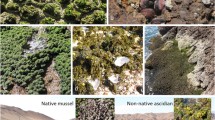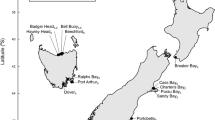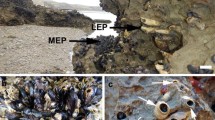Abstract
Native ecosystem engineers that add physical structure to ecosystems can facilitate invasive species. In this study we determined the effects of the native tube-forming serpulid worm, Galeolaria caespitose on the recruitment of the invasive New Zealand porcelain crab, Petrolisthes elongatus, and whether invasive crab recruitment was related to the recruitment of native species. P. elongatus is abundant beneath intertidal rocks around Tasmania, southern Australia, and the underside of these rocks is usually covered with a calcareous matrix formed by the serpulid. We used an experimental approach to investigate whether rocks, serpulids on the underside of rocks and adult P. elongatus influenced the recruitment P. elongatus and native communities. P. elongatus and native invertebrates only recruited in the presence of rocks indicating the importance of rock as primary recruitment habitat. Moreover, the presence of serpulids on the underside of rocks significantly increased the recruitment of P. elongatus and native invertebrates compared to rocks without serpulids. Rocks with higher densities of adult P. elongatus at the end of the experiment also had higher densities of P. elongatus recruits. The density of P. elongatus recruits did not influence native species richness and abundance although there was some evidence that high P. elongatus recruitment was correlated with shifts in native community structure. We have shown that a native ecosystem engineer facilitates recruitment of an invasive crab but this does not appear to influence the recruitment of native species.




Similar content being viewed by others
References
Altieri AH, van Wesenbeeck BK, Bertness MD, Silliman BR (2010) Facilitation cascade drives positive relationship between native biodiversity and invasion success. Ecology 91:1269–1275
Anderson MJ (2001) A new method for non-parametric multivariate analysis of variance. Austral Ecol 26:32–46
Anderson M, Gorley R, Clarke K (2008) PERMANOVA+ for PRIMER: guide to software and statistical methods. PRIMER-E, Plymouth
Bertness MD, Leonard GH, Levine JM, Schmidt PR, Ingraham AO (1999) Testing the relative contribution of positive and negative interactions in rocky intertidal communities. Ecology 80:2711–2726
Britton-Simmons KH (2004) Direct and indirect effects of the introduced alga Sargassum muticum on benthic, subtidal communities of Washington State, USA. Mar Ecol Prog Ser 277:61–78
Bulleri F, Benedetti-Cecchi L (2008) Facilitation of the introduced green alga Caulerpa racemosa by resident algal turfs: experimental evaluation of underlying mechanisms. Mar Ecol Prog Ser 364:77–86
Bulleri F, Bruno JF, Benedetti-Cecchi L (2008) Beyond competition: incorporating positive interactions between species to predict ecosystem invasibility. PLoS Biol 6:e162
Clarke K, Gorley R (2006) User manual/tutorial. PRIMER-E Ltd., Plymouth
Connell SD, Jones GP (1991) The influence of habitat complexity on postrecruitment processes in a temperate reef fish population. J Exp Mar Biol Ecol 151:271–294
DeRivera CE, Ruiz GM, Hines AH, Jivoff P (2005) Biotic resistance to invasion: native predator limits abundance and distribution of an introduced crab. Ecology 86:3364–3376
Donahue MJ (2006) Allee effects and conspecific cueing jointly lead to conspecific attraction. Oecologia 149:33–43
Forward RB, Tankersley RA, Rittschof D (2001) Cues for metamorphosis of Brachyuran crabs: an overview. Am Zool 41:1108–1122
Greenwood J (1965) The larval development of Petrolisthes elongatus (H. Milne Edwards) and Petrolisthes novaezelandiae Filhol (Anomura, Porcellanidae) with notes on breeding. Crustaceana 8:285–307
Gribben PE, I’Ons S, Phillips NE, Geange SW, Wright JT, Murray BR (2013) Biogeographic comparisons of the traits and abundance of an invasive crab throughout its native and invasive ranges. Biol Inv 15:1877–1885
Gribben PE, Simpson M, Wright JT (2015) Relationships between an invasive crab, habitat availability and intertidal community structure at biogeographic scales. Mar Environ Res 110:124–131
Grosholz ED, Ruiz GM, Dean CA, Shirley KA, Maron JL, Connors PG (2000) The impacts of a nonindigenous marine predator in a California bay. Ecology 81:1206–1224
Grosholz E, Lovell S, Besedin E, Katz M (2011) Modeling the impacts of the European green crab on commercial shellfisheries. Ecol Appl 21:915–924
Hastings A et al (2007) Ecosystem engineering in space and time. Ecol Lett 10:153–164
Hixon MA, Beets JP (1993) Predation, prey refuges, and the structure of coral-reef fish assemblages. Ecol Monogr 63:77–101
Hollebone AL, Hay ME (2007) Propagule pressure of an invasive crab overwhelms native biotic resistance. Mar Ecol Prog Ser 342:191–196
Hollebone AL, Hay ME (2008) An invasive crab alters interaction webs in a marine community. Biol Invasion 10:347–358
Jensen GC (1989) Gregarious settlement by megalopae of the porcelain crabs Petrolisthes cinctipes (Randall) and P. eriomerus Stimpson. J Exp Mar Biol Ecol 131:223–231
Jensen GC, Armstrong DA (1991) Intertidal zonation among congeners: factors regulating distribution of porcelain crabs Petrolisthes spp. (Anomura: Porcellanidae). Mar Ecol Prog Ser 73:47–60
Jensen GC, McDonald PS, Armstrong DA (2002) East meets west: competitive interactions between green crab Carcinus maenas, and native and introduced shore crab Hemigrapsus spp. Mar Ecol Prog Ser 225:251–262
Jones M (1977) Breeding and seasonal population changes of Petrolisthes elongatus (Crustacea, Decapoda, Anomura) at Kaikoura, New Zealand. J R Soc N Z 7:259–272
Jones CG, Lawton JH, Shachak M (1997) Positive and negative effects of organisms as physical ecosystem engineers. Ecology 78:1946–1957
Lockwood JL, Hoopes MF, Marchetti MP (2013) Invasion ecology. Wiley, Hoboken, NJ
Lohrer AM, Whitlatch RB (2002) Interactions among aliens: apparent replacement of one exotic species by another. Ecology 83:719–732
Lohrer AM, Fukui Y, Wada K, Whitlatch RB (2000) Structural complexity and vertical zonation of intertidal crabs, with focus on habitat requirements of the invasive Asian shore crab, Hemigrapsus sanguineus (de Haan). J Exp Mar Biol Ecol 244:203–217
McGuinness K (1987) Disturbance and organisms on boulders. Oecologia 71:420–430
Menge BA (1995) Indirect effects in marine rocky intertidal interaction webs: patterns and importance. Ecol Monogr 65:21–74
Ruesink JL (2007) Biotic resistance and facilitation of a non-native oyster on rocky shores. Mar Ecol Prog Ser 331:1–9
Ruiz G, Fofonoff P, Steves B, Dahlstrom A (2011) Marine crustacean invasions in North America: a synthesis of historical records and documented impacts. In: The wrong place-alien marine crustaceans: distribution, biology and impacts. Springer, New York City
Siddon CE, Witman JD (2004) Behavioral indirect interactions: multiple predator effects and prey switching in the rocky subtidal. Ecology 85:2938–2945
Stachowicz JJ, Whitlatch RB, Osman RW (1999) Species diversity and invasion resistance in a marine ecosystem. Science 286:1577–1579
Thomsen MS et al (2010) Habitat cascades: the conceptual context and global relevance of facilitation cascades via habitat formation and modification. Integr Comp Biol 50:158–175
Waller DM, Maas LI (2013) Do white-tailed deer and the exotic plant garlic mustard interact to affect the growth and persistence of native forest plants? For Ecol Manag 304:296–302
Wootton JT (1994) The nature and consequences of indirect effects in ecological communities. Ann Rev Ecol Syst 25:443–466
Author information
Authors and Affiliations
Corresponding author
Rights and permissions
About this article
Cite this article
Wright, J.T., Gribben, P.E. & Latzel, S. Native ecosystem engineer facilitates recruitment of invasive crab and native invertebrates. Biol Invasions 18, 3163–3173 (2016). https://doi.org/10.1007/s10530-016-1206-2
Received:
Accepted:
Published:
Issue Date:
DOI: https://doi.org/10.1007/s10530-016-1206-2




